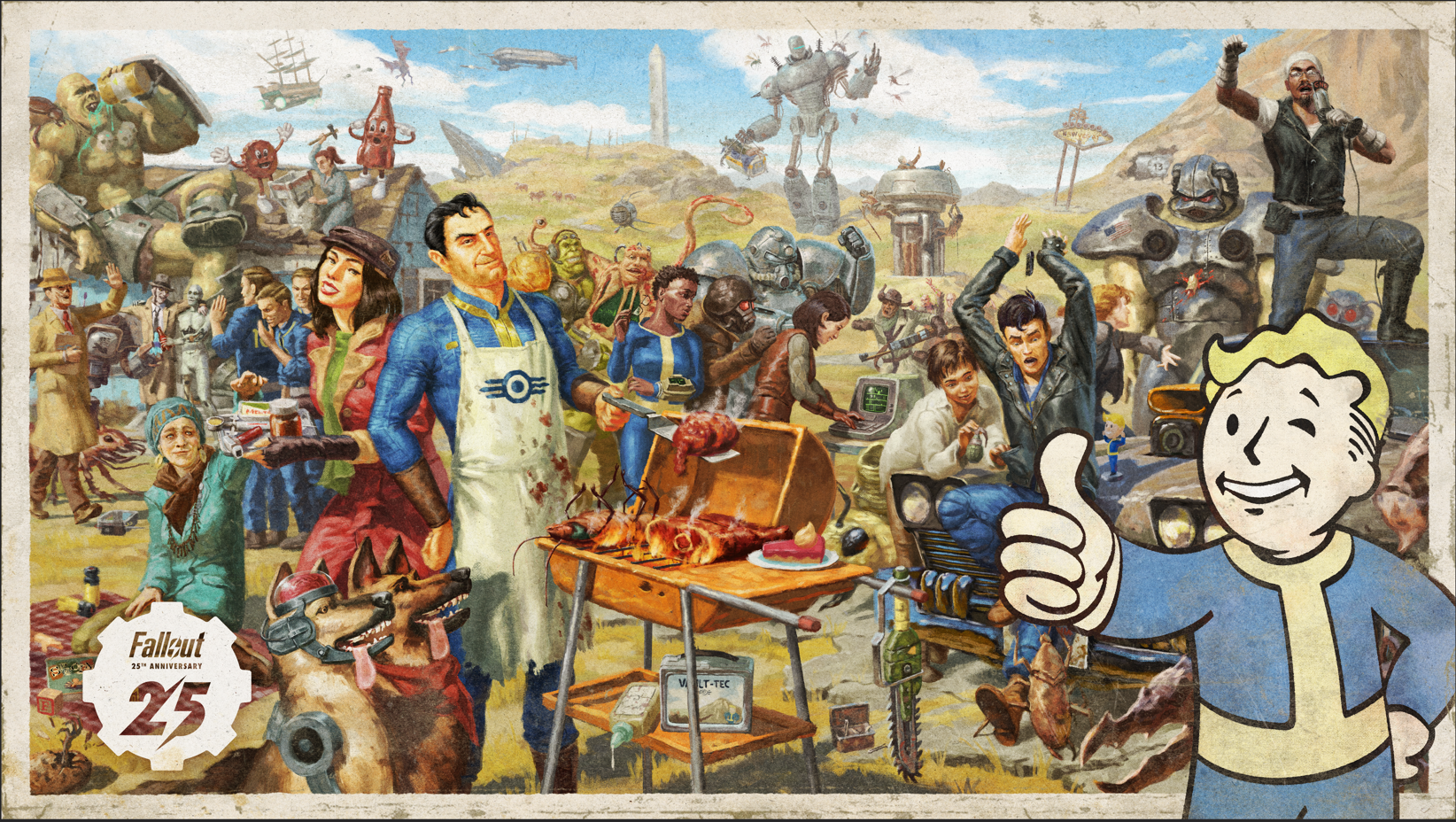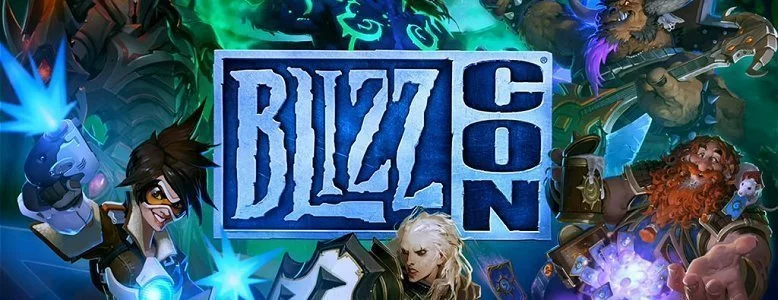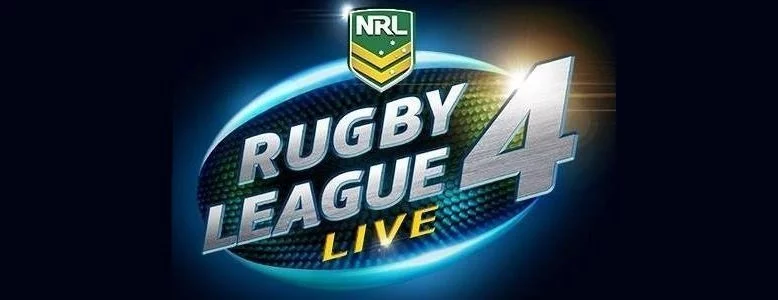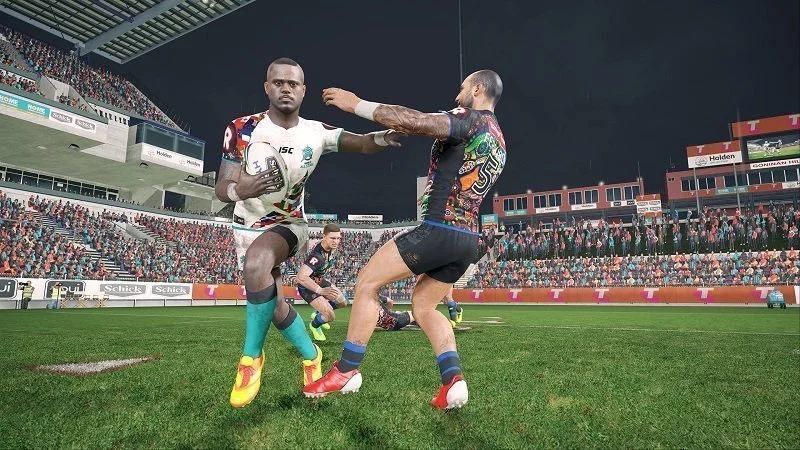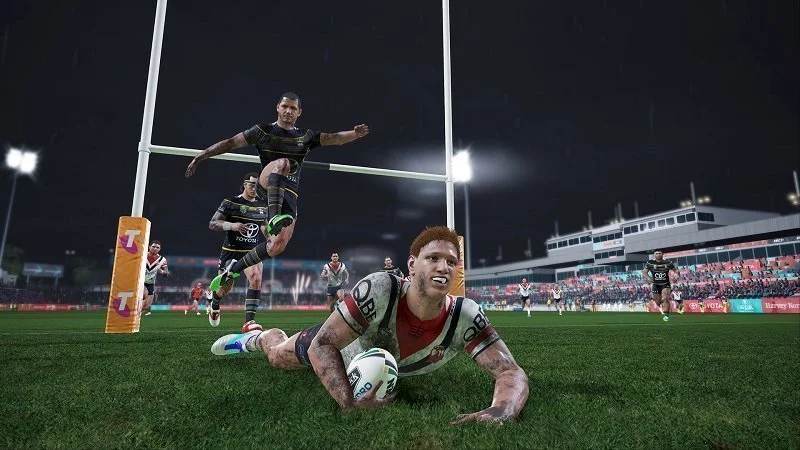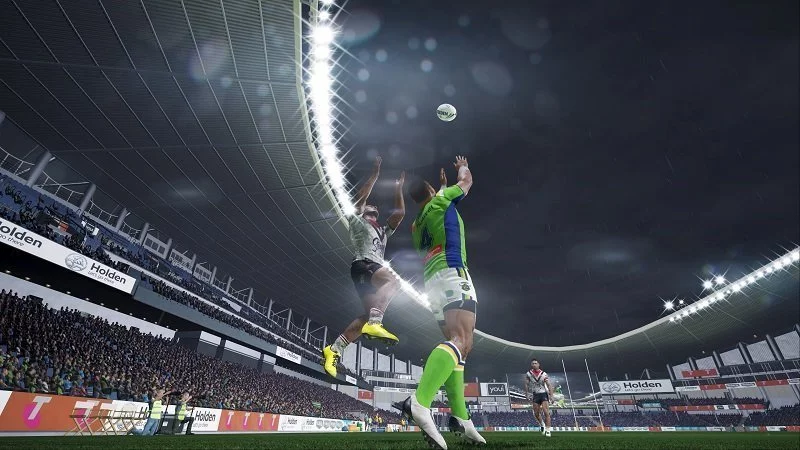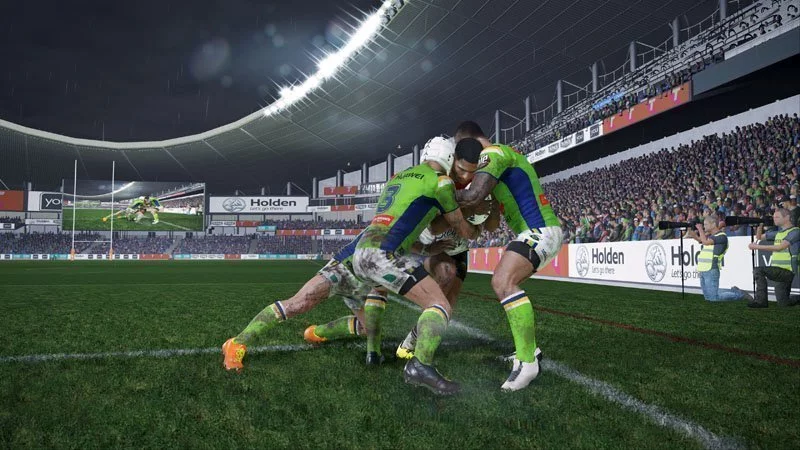As a proud New South Welshman I have gained a high tolerance for disappointment over the last 12 years. The feeling of being so near yet so far so many times is great preparation for being a fan of digital rugby league, for once again Big Ant Studios has produced a performance better than its last but one that is unlikely to draw any new fans to the grounds if they were unimpressed with previous efforts.
My initial draft of this review looked like a particularly productive bug tester’s log sheet. That isn’t to say Rugby League Live 4 is riddled with bugs like some of its predecessors, though the ones that occur do so at crucial moments and stand out so much in an otherwise solid simulation. Yet occur they do, and nearly every play session left me seething with frustration at the injustices suffered and dejected as another otherwise entertaining match left a sour taste. My defining memory of each play session wasn’t great tries scored from sweeping backline movements, it was the match winning penalty goal kicked after being penalised for not getting off the tackled player while I was holding him up in goal, and the match winning try scored when a grubber warped from the hands of Frank Pritchard into the grateful arms of Chris McQueen.
Taking a step back, Rugby League Live 4 does get a lot of “the greatest game of all” right. The ruck has once again been changed for the better, gone is frame perfect tackle timing and one-on-one strips (a brilliant and all-too rare decision to remove a feature for the sake of playability), replaced by an ability to square up in defence that creates the chance for driving tackles alongside the standard high risk/high reward big hit button. Momentum into the tackle is critical for both ball carrier and defender, though there are still too many awkward moments where defenders drive a player back in a tackle against all laws of physics. It is mercifully infrequent close to the line thank goodness, so unstoppable bargeover tries are rare, though not eliminated completely.
There is still the occasional moment where what is an obvious tackling situation doesn’t result in tackles, and more than a few replays of tries the AI scored saw my controlled defender shuffling right next to the ball carrier but not engaging in contact, or an AI controlled defender just choosing not to close a gap in the line. Despite these flaws, squaring up is a game changer for defensive control, particularly in Be A Player mode where keeping your spot in the defensive line is now a lot easier.
The play the ball is a little rougher, where lip service is paid to quick play-the-balls but too often the tackled player is slow to their feet and the defensive line completely resets on all but the most rare of occasions. Your markers have a much tougher time shuffling slowly to their set positions, and getting caught one step away from said position will see them judged offside and targeted by the ruthless AI dummy half. If there is a way to struggle in the play-the-ball to get up quicker it isn’t listed in the controls, help screens or tutorials, and attempting the same methods used in Rugby League Live 3 didn’t have any noticeable effect.
This results in you always attacking a set defensive line, leading to most breaks coming from beating a defender one on one. There are plenty of ways to do this, the sidestep animations have improved but still infuriatingly take control away from your defender if you fail the die roll and the game judges you to be sidestepped. A hit-up throws a shoulder into the defender and is a great way to gain extra metres and the fend is brutally effective from the right players, trying to stop Jason Taumalolo or Sam Burgess close to the line is an exercise in frustration.
One way you will struggle to break a line is from sweeping passing plays. Passes are often floaty and the AI defensive line slides like a well-drilled Craig Bellamy side, leaving inside balls and second phase play your best shots at attacking football. It would be nice to be able to get a quick play-the-ball and shift through the hands to exploit an overlap, but this traditional form of attacking play just isn’t seen in Rugby League Live 4. It is all about the individual showmanship, the step, the fend, the chip and chase or the grubber.
Kicking has seen some progress and some regression. The baffling decision has been made to remove the slow motion kicking controls of the last 15 years of rugby league games, naturally returning us to the dark ages of kicking straight into the charging defenders should you have the gall to want to direct or add more power to your kick. If your halfback decides to take the ball on the fourth or fifth on the run, forget about getting your kick away. There are set plays you can use to give your kicker more room, but too often you will put in unconvincing clearing kicks or inaccurate bombs that start your defensive set on the back foot.
Better is place kicking, a new system heavily influenced by modern Madden games and probably my favourite implementation of goal kicking in any rugby game ever. It accounts well for kicker skill, the wind, and degree of difficulty while still giving you plenty of options from a wide, curling Thurston-esque trick shot to drilling the ball straight and low to push through heavy winds. On kickoffs the unfortunate decision has been made to allow you to boot the ball dead if you give a kick full power, adding an unnecessary layer of risk to a perfunctory part of video game rugby league. Much like Madden games have gradually reduced offensive holding calls and random false starts, some rules in this complex sport just don’t need to be reproduced in its virtual forms.
Also new to Rugby League Live 4 are set attacking plays, on the fly interchanges and foresight mode, where you can briefly highlight the skills of each player on the field in strength, stamina, fitness, agility and speed. Foresight is good in theory but in practice I rarely used it, knowing where weaker defenders were in the line wasn’t worth the couple of d-pad taps it took to trigger. The set plays are more useful, allowing you to call for inside runners, straight hit-ups or cross plays. Defensive shifts return as well though players treat a shift call more as a guideline than a command. My favourite new addition is the contested catch gauge, adding a simple timing element to leaping for a bomb and taking the ambiguity out of this crucial aspect of the game. More flexible player switching options are appreciated and go some way to fixing a long standing complaint with the series, though I still ended up switching to baffling players when chasing down a break, the one time it is most crucial. In general play, it is a lot better.
Despite the regular claims that comparing Rugby League Live to Madden or FIFA is unfair, what with the massive disparity in budgets and team sizes, Big Ant sure invites said comparisons by attempting to match the EA juggernauts in terms of features and presentation. That isn’t to say you can compare the two side by side, but coming out for the second half of my first game to find the skies had opened up and the four shadows of stadium lighting had replaced the single shadows of sunlight was a legitimately impressive moment, highlighting new dynamic lighting and weather features. That the wind changed direction for each place kick I took in the game was less impressive, but baby steps.
Eddie Hemmings makes his first video game commentary appearance in 20 years, alongside long time series staple Andrew Voss. Voss is as eccentric as usual while Hemmings doesn’t really add much as a colour man. I certainly got sick of Voss criticising me for not using my full set as I dared to attempt a 40/20 kick on the fourth tackle. The soundtrack was filled by walking down to a uni bar for Thursday night battle of the bands and taking demo CDs, and it sounds like they didn’t even pick tunes from the winners. There are a couple of particularly atrocious songs on there.
The stadiums looks great and animations have improved, though replays will highlight a few running animations that look like the team kit only supplied shorts in extra small that day. There are thousands of players and hundreds of teams, all the ones you care about have decent facial modelling though lower graders get the “intern with the create-a-player and a team photo” treatment. All of the best in class creation tools that have become standard in the Big Ant/Tru Blu series of sports games return here better than ever, with online sharing well integrated. A Create A Stadium mode is new, allowing me to poorly replicate the sadly demolished Parramatta Stadium and other more creative types to undoubtedly design more impressive arenas. You won’t need to be customising teams straight away, rosters are accurate to July 2017, though player and team attributes use a very tight scale and some questionable ratings exist. Newcastle are a historically bad team, yet at 77 rate only 9 points lower than the 86 rated Australian side? And I thought the old 7-10 rating scale for games was bad.
Be A Player and career mode return though I feel only the most dedicated fans will notice any changes, to me it felt eerily similar to Rugby League Live 3. For the first time in a rugby game I really enjoyed controlling a single player, a mode I have found little more than a novelty in the past. Whether that enjoyment will extend beyond a few games I’m not sure, but for now the more restrained AI, better defensive controls and perhaps the fact that limiting your control to one player also limits how many bugs you can expose, left me having my most fun in Rugby League Live 4 when I stepped into the shoes of Mitchell Moses and led my beloved Eels around the park.
But back to those bugs. Rugby League Live 4 has gone all-in on the simulation route. It is a more restrained game than its predecessors, emphasising winning the ruck and playing for field position to create scoring opportunities, just like the real thing. At its best it succeeds; many of these elements could use some fine tuning but for large parts of my time with Rugby League Live 4 I was having fun, I was engaged in the battle of the ruck and I felt a sense of satisfaction as I gained ascendancy through the middle of the park.
Hardcore simulations leave no room for error. Results can hinge on a single shift of momentum, a controversial penalty, an undeserved repeat set, a magic warping ball that turns a crucial defensive play into a try conceded. Almost every game I played saw at least one or two baffling failures, often turning wins into losses and those satisfied smiles into controller throwing frustration and anger. Some were exploitable in my favour if I chose to go down that path, the AI isn’t great at catching bombs and sometimes decides to leave them to bounce dead, a poor choice when Bevan French is chasing through. The AI likes to throw forward passes from tap restarts and there was one occasion that Jarrod Croker ran overlapped with Michael Jennings for 90 metres, refusing to make a try saving tackle.
Those aren’t the moments that stick with you though. A match winning penalty goal kicked because you were judged to have held down a player that had already offloaded the ball, or worse, was held up in goal. That you remember. The AI constantly exploiting its own inability to get your makers into position to get cheap penalties. Watching the opposing fullback run a 40/20 attempt over the sidelines as he tries to field it, only to see his side get the scrum feed. Kudos to the guy cutting the gameplay trailers, the only job harder than finding a minute of bug free try scoring in Rugby League Live 4 would be putting together the Tim Glasby highlights package for the State of Origin pregame.
It all adds up and it wears you down. I want to love this game, I want to play an excellent digital version of the sport I love. To have the best shot at that in 20 years ripped from my hands by bullsh*t over and over again, it sucks. I’ve never been more invested in a rugby league video game than the best moments I had with Rugby League Live 4, but without fail it was stripped away from me every time, leaving me frustrated, angry. Leaving me disappointed.
I don’t doubt that plenty of people will be able to play around these issues, that they will master the game’s limitations on its own terms and have a lot of fun with it. I’m just sick of having to give a game so much benefit of the doubt. To spend hours deciphering its mechanics because its tutorial modes have somehow gotten worse in the last two years, to work at that one specific play style that hides the flaws, to remember a dozen different situations that I need to avoid to circumvent bugs.
I don’t have to compromise to enjoy the big budget sports games the developers hate us comparing them to, but I also don’t have to compromise to enjoy smaller sports titles like Super Mega Baseball or The Golf Club 2 that limit their scope and master what they choose to tackle. Rugby League Live 4 has grand ambitions that I can’t help but feel it will never be able to achieve. Rugby league is an incredibly complex but also very small sport beloved by one coast of Australia, some of the north of England and of course, Papua New Guinea (did you hear it is the national sport?) Maybe a hardcore simulation of something so complex for a market so small is just not meant to be and Big Ant would be better off investing in a simpler but tighter experience. If you can’t make the FIFA of rugby league, make the Blitz or Street of league instead.
But that is just me. If you could forgive Rugby League Live 3 its flaws and enjoy it, then this sequel will leave you as happy as Fatty and King Wally after Origin 3. Everything about the gameplay is tighter; from the improved ruck and play-the-ball to a more realistic AI that flings passes around less but ruthlessly punishes you for shooting out of the line or attempting to stop a big man with a little one. You will find ways to work around the flaws and bugs and learn to push the game to its limits to extract a solid facsimile of rugby league. If that sounds like you, you probably didn’t need to read these 2500 words to know that Rugby League Live 4 won’t disappoint you. For those of us that found the previous Live games unsatisfying, we’ll always have the Blues.
If you are interested in the history of rugby games both league and union, check out my series “One Game at a Time” which is chronicling every rugby game ever made. You can start with the home computer era of the 80s here at Part One, join in for the first rugby league games at Part Four, see the classic ARL 96 in Part Six, and the immortal Jonah Lomu Rugby in Part Seven.
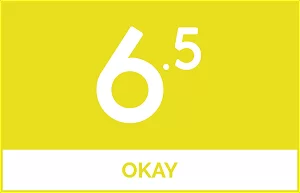 |
|
The good
|
The bad
|
Rugby League Live 4 was reviewed using a promotional code on Xbox One, as provided by the publisher. Click here to learn more about Stevivor’s scoring scale.
This article may contain affiliate links, meaning we could earn a small commission if you click-through and make a purchase. Stevivor is an independent outlet and our journalism is in no way influenced by any advertiser or commercial initiative.


